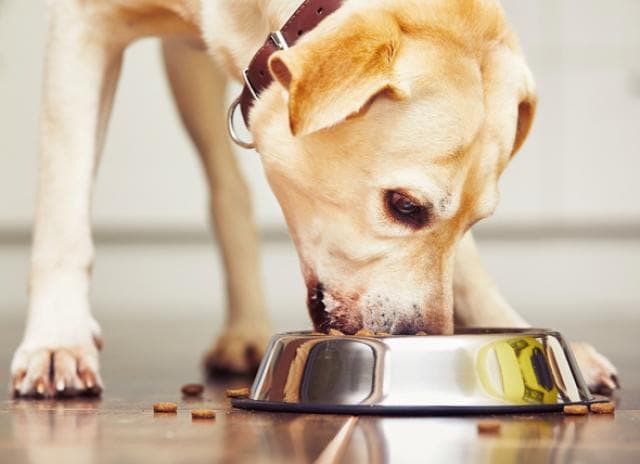What Is the Best Food to Feed a Dog With Pancreatitis

The pancreas is not an organ that many pet parents have reason to retrieve virtually—that is, until something goes wrong with it. Pancreatitis is the nigh common disease of the pancreas in dogs. Let's investigate the causes and symptoms of pancreatitis in dogs and what tin can be done to forestall and treat this serious condition, including the role that a depression-fat dog food tin play.
Causes of Pancreatitis in Dogs
Dogs can develop pancreatitis for a number of reasons, including:
-
Eating something with a loftier-fat content, particularly if it is not part of their regular nutrition
-
Being overweight
-
Pancreatic infections
-
Having other medical conditions like Cushing'southward illness, diabetes mellitus, or abnormally high levels of fat in the blood
-
Exposure to some types of medications or toxins, including organophosphates, L-asparaginase, azathioprine, corticosteroids, sulphonamides, potassium bromide, phenobarbital, and zinc
-
Abdominal trauma that affects the pancreas
-
A genetic or breed predisposition (Miniature Schnauzers, Yorkshire Terriers, Silky Terriers, Miniature Poodles)
-
A history of pancreatitis
In many cases, no specific underlying cause can be identified.
Symptoms of Pancreatitis in Dogs
The pancreas has several functions in the body, one of which is making digestive enzymes. In skillful health, these enzymes remain inactive until they are secreted into the intestinal tract in response to a recent meal.
While the exact mechanisms are unclear, pancreatitis develops when these digestive enzymes first working prematurely, while they are nonetheless within the pancreas, leading to pancreatic inflammation and sometimes infection and/or tissue death.
Pancreatitis may be balmy or severe. Information technology can develop of a sudden or over a long period of time. Information technology may happen once or become a recurrent or chronic problem. All of this explains why the symptoms of pancreatitis in dogs can vary tremendously. Dogs with pancreatitis typically have some combination of the post-obit symptoms:
-
Lethargy
-
Abdominal discomfort/pain
-
Poor appetite
-
Vomiting
-
Diarrhea
-
Abdominal enlargement
-
Fever
None of these symptoms are specific for pancreatitis in dogs. To make a definitive diagnosis, a veterinarian will have to run some tests, starting with a blood chemistry panel, complete blood prison cell count, fecal examination, urinalysis, and perchance some abdominal X-rays to rule out other diseases that cause like symptoms.
This initial workup may point to pancreatitis, but boosted testing (eastward.thou., cPLI or SPEC-CPL blood tests) is unremarkably also necessary. Sometimes abdominal ultrasounds, exploratory surgery, or other diagnostic procedures are needed to reach a definitive diagnosis of pancreatitis in dogs.
Treatment for Pancreatitis in Dogs
Handling for pancreatitis will depend on a dog's symptoms and any abnormalities that were detected on his blood piece of work and urinalysis. The goal is to keep the patient comfortable and back up his physiological needs while giving the pancreas time to heal.
Fluid therapy and dog medications to control nausea and pain are often necessary. Your veterinary may prescribe dog antibiotics to care for or prevent infection. Severely affected dogs may need to be hospitalized for an extended period of time and crave more ambitious treatment with feeding tubes, plasma transfusion, or surgery.
Research has constitute that dogs with pancreatitis who chop-chop start eating domestic dog nutrient once again have an improved prognosis. Therefore, veterinarians aggressively use anti-nausea drugs to treat vomiting in attempt to get nutrient into dogs with pancreatitis equally shortly every bit possible.
Dog Food for Pancreatitis
Nearly veterinarians recommend that dogs eat a highly digestible, low-fat dog food as they are recovering from pancreatitis. Dietary fatty is thought to be a major stimulus for the pancreas to secrete digestive enzymes, which may worsen pancreatic inflammation.
A low-fat domestic dog food can promote pancreatic healing while even so providing all the nutrition dogs demand to heal. If your dog has a history of repeated bouts of pancreatitis, your veterinary may recommend that you continue to feed a low-fat dog nutrient to prevent flare-ups.
Several well-respected pet food companies make dog food formulas that are specifically designed to help dogs recover from pancreatitis. Loma's domestic dog foods include Hill's Prescription Diet i/d Low Fat Canned Dog Food and Hill'due south Prescription Nutrition i/d Low Fat Dry Dog Food, both of which are supplemented with omega-3 fatty acids that have been shown to reduce inflammation.
Royal Canin Veterinarian Diet Gastrointestinal Depression Fat Canned Domestic dog Food and Royal Canin Veterinary Diet Gastrointestinal Low Fat Dry out Dog Food also comprise omega-3 fatty acids and have the least amount of fat of any canned and dry dog foods currently on the market place.
Purina Pro Plan Veterinary Diets EN Gastroenteric Formula Canned Dog Food and Purina Pro Plan Veterinarian Diets EN Gastroenteric Formula Dry Domestic dog Food have higher fatty contents than either the Hill's dog foods or Majestic Canin veterinary diets mentioned above, but may be an option for dogs who don't benefit from strict fat reduction.
Talk to your veterinarian for help in picking the best dog food for pancreatitis based on the specifics of your dog's case.
Image via Jaromir Chalabala/Shutterstock
gallionlostactunce95.blogspot.com
Source: https://www.petmd.com/dog/what-you-need-know-about-dog-food-pancreatitis-0
0 Response to "What Is the Best Food to Feed a Dog With Pancreatitis"
Postar um comentário